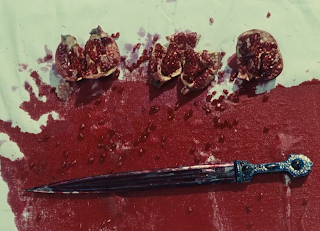Poetry as pure cinematic means and cinema as the canvas used to portray poetry. This is a film of beauty, not only beauty within art and poetry but life, love, faith and any meaning we want to abstract. If you see abstract films being daunting due to the heavy reliance on symbolism, fear not because meaning (like beauty) depends on the eye of the beholder. When watching this film, the intellectuals will grasp the rich commentary on Armenian culture and history, the simple yet melancholic people like myself will hold to the sentimentalism and rich existentialism this film unravels.
The pomegranate fruit to which the film owes its title, is referenced constantly through its runtime either as juice, seeds or as a tool for coloring. The color of the pomegranates (literally) is both the means to express art and the inspiration for the artist. This film works in a very similar way as the 1992 film “Dream of Light”, directed by Victor Erice works: art (film) is used to depict an artist’s inspiration to craft art so that we can ponder and obtain our own meaning. In other words, it is art within art, which at the same time takes inspiration from nature. For Erice it was Antonio Lopez and his painting and for Parajanov it was Sayat-Nova and his poetry, but in any case we start with fruit, beauty exists in art not because of the craft but because of nature.
The poetic ease and religious imagery within this film feels akin to Tarkovsky, however while Tarkovsky blatantly rejected film montage, Parajanov creates a visual tone poem with montage as its moving force. We can extract meaning thanks to the sequence of shots instead of the ambience, of course every shot overflows with symbology but it is not the ambience but the succession of these symbols what gives them a new meaning.
This is particularly evidenced in the following montage:
“The world is a window and I’m tired of these arches”
The last three shots of the sequence evoke war and despair: bloodshed, artistic liberty shattered (as the pomegranates are cut in half) and crosses resembling a graveyard. However, notice that these are preceded by a shot of a cracked arch, if a window serves to let light through it, then it is the arch the one that limits it. The grief within this world to which Sayat-Nova constantly shudders is what limits us to grasp the beauty within the light.
Also, notice the first shot. It reminds us of a previous motif within the film:
A skull dressed with a helmet, a depiction not only of death but of war. On the sequence I first displayed, the man is rather contemplating the skull, a way to depict how he is trying to find meaning in the grotesque or understand the nature of grief. On the second sequence I showed however, the man doesn’t contemplate it but instead he covers his face.
Before this shot the first two displayed soil and a rooster, once again we deal with nature used as a symbol, in this case of sacrifice. Constantly the film poses the search of a selfless love, some of which will find it through faith and in such case this shot might represent the helplessness of humanity in which we might feel neglected by God. Maybe others will find selfless love through either romantic attachment or human bonding, either way we are remembered that love requires sacrifice and that it isn’t easily obtained, to love is to be vulnerable but the reward is everything as it is the light that passes through the window, even if a cracked arch obstructs our vision.







